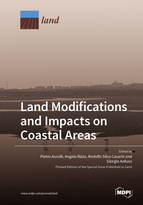Land Modifications and Impacts on Coastal Areas
A special issue of Land (ISSN 2073-445X). This special issue belongs to the section "Land Systems and Global Change".
Deadline for manuscript submissions: closed (15 July 2022) | Viewed by 37760
Special Issue Editors
Interests: geomorphology; climate change impacts; coastal processes; sea level changes and tectonics; quaternary geology; geological and geomorphological mapping; geographic information systems; risk assessment
Special Issues, Collections and Topics in MDPI journals
Interests: coastal geomorphology; risk assessment; climate change; sea level change; geomorphological mapping; geographic information systems
Special Issues, Collections and Topics in MDPI journals
Interests: coastal green infrastructure; coastal morphodynamics; physical oceanography; integrated coastal zone management; oceanographic risk; marine energy harnessing; rehabilitation and protection of coastal ecosystems
Special Issues, Collections and Topics in MDPI journals
Interests: coastal geomorphology; coastal short-term evolution; disturbance depth; seasonal evolution; historical changes
Special Issues, Collections and Topics in MDPI journals
Special Issue Information
Dear Colleagues,
Coastal areas are zones that are extremely influenced by climatic and anthropogenic-driven factors acting both at the local and global scales.
Among them, ongoing and expected land use and land cover changes, as well as catchment management activities and exploitation of natural resources, can influence the evolution of the coastal environments and landscapes, whose changes can, directly and indirectly, influence human economic assets and pose under pressure coastal habitats and related ecosystem services.
Interdisciplinary research has highlighted that low-lying coasts, worldwide, are currently subject to erosion, retreat, and flooding, and that these processes are expected to increase in intensity and frequency because of climate change consequences. Coastal areas play a relevant role in conditioning and providing those ecosystem services that are able to enforce coastal resilience against such extreme marine events.
The identification of the driving factors inducing coastal modifications, as well as the implementation of tailored solutions for coping with the potential consequences of climate change and land modification on biodiversity, ecosystems, and anthropic activities, to represent key factors for supporting the sustainable management of the coastal zone, under a climate adaptation perspective.
This SI “Land Modifications and Impacts on Coastal Areas” is aimed at collecting case studies from different zones across the world whose local economies and services strongly rely on marine and coastal assets conditioning marine activities, such as tourism and fishing. With the aim of covering a comprehensive assessment of the interaction of natural and anthropic drivers inducing such modifications, we encourage authors to submit contributions in the following priority areas:
- Coastal evolution at different spatial and temporal scales;
- Effects of human activities on coastline dynamic;
- Impacts of extreme events and climate-related processes;
- Traditional and “green engineering” modalities in coastal protection;
- Mapping of land uses and land cover variations in coastal areas;
- Advances in coastal landscape geomorphological evolution;
- Agricultural activities in coastal areas;
- Effects of saltwater intrusion;
- Coastal area over-settlement.
Prof. Dr. Pietro Aucelli
Dr. Angela Rizzo
Prof. Dr. Rodolfo Silva Casarín
Prof. Dr. Giorgio Anfuso
Guest Editors
Manuscript Submission Information
Manuscripts should be submitted online at www.mdpi.com by registering and logging in to this website. Once you are registered, click here to go to the submission form. Manuscripts can be submitted until the deadline. All submissions that pass pre-check are peer-reviewed. Accepted papers will be published continuously in the journal (as soon as accepted) and will be listed together on the special issue website. Research articles, review articles as well as short communications are invited. For planned papers, a title and short abstract (about 100 words) can be sent to the Editorial Office for announcement on this website.
Submitted manuscripts should not have been published previously, nor be under consideration for publication elsewhere (except conference proceedings papers). All manuscripts are thoroughly refereed through a single-blind peer-review process. A guide for authors and other relevant information for submission of manuscripts is available on the Instructions for Authors page. Land is an international peer-reviewed open access monthly journal published by MDPI.
Please visit the Instructions for Authors page before submitting a manuscript. The Article Processing Charge (APC) for publication in this open access journal is 2600 CHF (Swiss Francs). Submitted papers should be well formatted and use good English. Authors may use MDPI's English editing service prior to publication or during author revisions.
Keywords
- coastal evolution
- land use changes
- watershed management
- climate change impacts
- anthropic impacts









